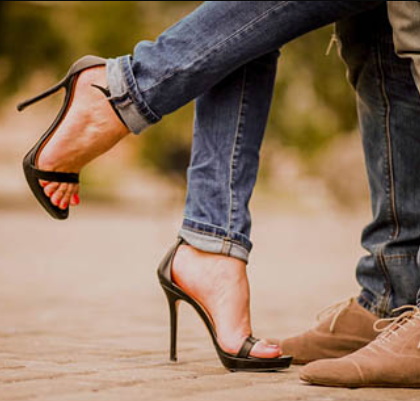Content Menu
● Understanding Shoe Dangle
>> The Mechanics of Shoe Dangle
● Psychological Implications
● Social Signals
● Cultural Context
>> Historical Perspectives
● Practical Reasons for Shoe Dangle
● The Role of Body Language
>> The Psychology Behind It
● Gender Dynamics
● Conclusion
● FAQs
>> 1. Is shoe dangling always a sign of flirtation?
>> 2. Do all women dangle their shoes?
>> 3. Can shoe dangling indicate discomfort?
>> 4. Is shoe dangling considered unprofessional?
>> 5. What types of shoes are most commonly dangled?
The act of dangling shoes is a behavior often observed in women, particularly in social settings. This seemingly simple gesture can carry a variety of meanings and implications, from comfort and relaxation to flirtation and self-expression. In this article, we will explore the reasons behind this behavior, its psychological and social significance, and how it fits into broader cultural contexts.

Understanding Shoe Dangle
What is Shoe Dangle?
Shoe dangling refers to the act of letting a shoe hang loosely from the toes, often while sitting. This can occur with various types of footwear, including flats, heels, and sandals. The action can be seen as a casual or playful gesture, but it often has deeper connotations.
The Mechanics of Shoe Dangle
When a woman dangles her shoe, several physical factors come into play:
- Footwear Design: Shoes that are designed to fit snugly may not dangle easily. Conversely, looser shoes are more likely to be dangled.
- Posture: The way a person sits can facilitate or hinder shoe dangling. For instance, sitting with legs crossed or stretched out can create opportunities for this behavior.
- Comfort Level: Often, women may dangle their shoes when they feel comfortable in their environment, indicating a sense of ease.
Psychological Implications
Comfort and Relaxation
One primary reason women dangle their shoes is to find comfort. High heels or tight-fitting shoes can become uncomfortable over time. By letting their shoes dangle, women may be seeking relief from discomfort, allowing their feet to breathe.
Fidgeting and Anxiety
For some women, dangling shoes serves as a fidgeting mechanism. Similar to how people might tap their fingers or bounce their legs when anxious or bored, shoe dangling can provide a subtle outlet for nervous energy.
Social Signals
Flirtation
In many social contexts, dangling shoes can be interpreted as a flirtatious gesture. It draws attention to the feet and legs, which are often considered attractive features. This behavior might signal openness or interest in engaging with others.
- Body Language: The positioning of the feet can communicate various messages about attraction and availability. For instance, if a woman is facing someone while dangling her shoe, it may indicate she is interested in that person.
Attention-Seeking
Some women may use shoe dangling as a way to attract attention in social settings. This behavior can be particularly effective in mixed-gender environments where physical appearance plays a significant role in social dynamics.
Cultural Context
The cultural significance of shoe dangling varies across different societies. In some cultures, it may be seen as an expression of femininity or flirtation, while in others it could be perceived as unprofessional or inappropriate.
Historical Perspectives
Historically, women's fashion has often included elements that emphasize femininity and attraction. High heels and stylish footwear have been designed not just for aesthetics but also to enhance the allure of the wearer. Shoe dangling can thus be viewed as an extension of these cultural norms surrounding women's fashion.

Practical Reasons for Shoe Dangle
Foot Pain Relief
Many women experience discomfort from wearing high heels or tight shoes for extended periods. Danging shoes allows them to relieve pressure on their feet without fully removing their footwear.
- Social Settings: In environments like restaurants or parties where removing shoes might not be appropriate, dangling provides a discreet way to alleviate discomfort.
Fashion Statement
Shoe dangling can also serve as a fashion statement. Some women may intentionally choose footwear that allows for this behavior as part of their personal style.
The Role of Body Language
Understanding the nuances behind shoe dangling also involves interpreting body language more broadly. Feet are powerful indicators of emotional states and intentions:
- Feet Positioning: A foot pointed towards someone typically indicates interest or attraction. Conversely, if the foot is turned away, it may suggest disinterest or discomfort.
- Movement: The act of moving the foot while dangling the shoe can invite attention and indicate playfulness or flirtation.
The Psychology Behind It
Psychologically speaking, body language plays a crucial role in human interaction. The subconscious signals sent through actions like shoe dangling can reveal much about a person's feelings:
- Comfort Levels: When someone feels at ease in their surroundings, they are more likely to exhibit open body language—such as dangling their shoes.
- Attraction Indicators: Research suggests that specific foot movements can indicate attraction; for instance, if a woman's foot is positioned towards someone while she dangles her shoe, it might signal her interest in that person.
Gender Dynamics
The act of shoe dangling also reflects broader gender dynamics in society:
- Cultural Expectations: Women are often socialized to express themselves through body language more than men. As such, behaviors like shoe dangling may serve as subtle ways for women to communicate interest or comfort without using words.
- Societal Norms: In many cultures, women are expected to maintain certain standards of femininity and attractiveness. Shoe dangling can align with these expectations by emphasizing the legs and footwear.
Conclusion
In summary, the act of dangling shoes is multifaceted and can signify comfort, anxiety relief, flirtation, or even fashion sensibilities. Understanding this behavior requires considering both individual psychology and broader cultural contexts. As society continues to evolve in its understanding of gender expressions and body language, so too will our interpretations of such gestures.

FAQs
1. Is shoe dangling always a sign of flirtation?
While it can indicate flirtation in certain contexts, shoe dangling may also simply reflect comfort or nervous energy.
2. Do all women dangle their shoes?
Not all women engage in this behavior; it varies based on personal habits and comfort levels with footwear.
3. Can shoe dangling indicate discomfort?
Yes, many women dangle their shoes to relieve discomfort from tight-fitting footwear.
4. Is shoe dangling considered unprofessional?
In some professional settings, it might be viewed as inappropriate; context matters greatly.
5. What types of shoes are most commonly dangled?
Flats and heels are commonly dangled due to their design; however, sandals may also be included depending on fit.
The love for beauty will never change, please Contact Us and choose what you like!



























